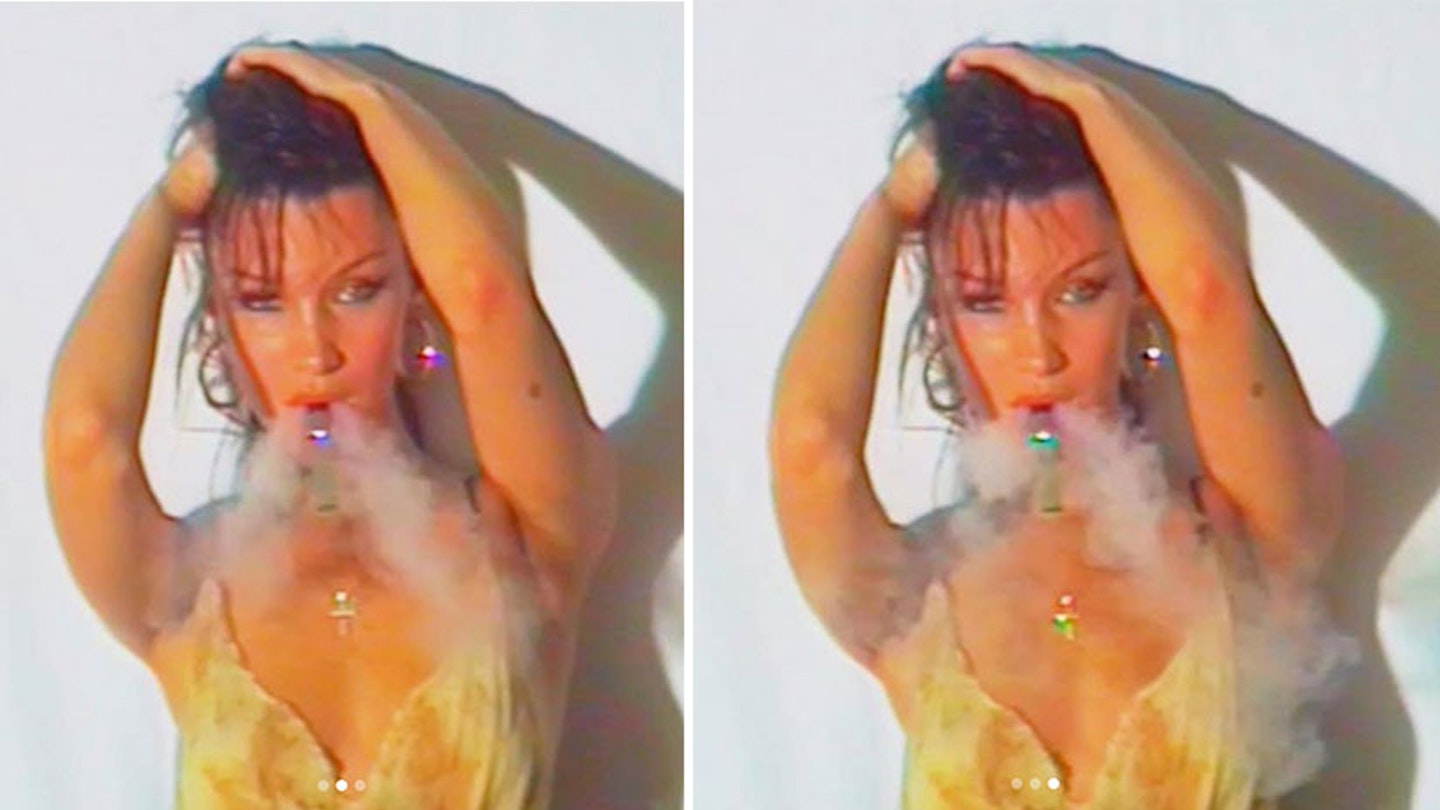A plume of smoke erupted from Naomi Campbells’ mouth as she sat ‘JUULing’ on the front row of the recent Sacai show at Paris Fashion Week. That simple intake and outtake of breath was a universal signal that smoking has a new acceptable face.
Over the last four years, the vape brand JUUL Labs has stolen the market share of the e-cig economy. In the US it accounts for an astounding 72 per cent of sales, according to Nielsen data, and in December it completed a new round of corporate funding that raised $12.8bn (£9.7bn). As traditional tobacco companies watch their consumer growth stagnate, this San Franciscan upstart is flourishing.
There are over 341K posts on Instagram about JUUL, including a striking gallery Bella Hadid posted last October of the slick little device balancing on the lip of her mouth. Search Youtube and you’re met thing over 400K videos on everything from tips and tricks to one viral comedy clip (watched by close to 5million) named ‘Dude, Where’s My JUUL’.
Vapes have traditionally mimicked the look, feel and taste of a cigarette with long tubular structures and a glowing tip. Designed to look elegant and discreet, like a flash drive (it even charges in a USB dock) JUUL resembles something entirely new. Hence, it’s nickname, the ‘iPhone of e-cigarettes’. Knowingly, James Monsees, one of the company’s founders told FastCompany, ‘people wanted to move past cigarette’.
The design eradicates the baggage of cigarettes. Puffing a JUUL is a totally different ritual to smoking. Each intake is standardized and is delivered by a pod which contains a mix of nicotine and benzonic acid. The result? A deep hit of nicotine. ‘These are luxury experiences for lack of a better way to put it. Smoking anything, the whole smoking experience, is not like eating, right? You don’t have to do it but you want to do it,’ Monsees told Social Underground.
You could say, the negative connotations were vapourised and in their place appeared a new aftermarket that sells vapeskins, cases and coats with perfectly sized JUUL pockets. At the extreme end, the jewellery company Minsai sell a luxury handcrafted 18-karat gold case for £4,750 (over 190 times the cost of the actual device). Meanwhile, Etsy is selling over 1,144 related products including trackers, wraps and lanyards.
‘There's this whole sort of individuality, DIY aspect to JUULing because they're so innocuous,’ Brian Trunzo, a senior consultant at WGSN told [Fashionista](https://fashionista.com/2019/01/fashion-juul-vaping-clothing-accessories https://www.youtube.com/watch?v=9xvWFAMrfI0), ‘You really do need to either mark your Juul or provide an accessory so you don't lose it or have it stolen from you at a party or bar. Tapping into people's desire to showcase their own individuality just makes complete sense.’
The name plays on the design of the gadget. Obviously, it riffs on the word jewel but it also co-opts the idea of something precious, something to be shown off like an object of beauty.
In 2015 JUUL was launched after a culmination of ventures by two graduates of the product design program at Sandford University. James Monsees and Adam Bowen were both smokers before the embarked on redesigning the intake of nicotine.
The success of Bowen and Monsees vape project is a double-edged sword. In December, four months after the company launched in the UK, Public Health England said that e-cigarettes are 95 per cent safer than tobacco. However, in the US the Food and Drug Administration is rethinking its stance on the product.
Scott Gottlieb, the FDA's commissioner, called e-cigs an ‘existential threat’ on Saturday. There has been a stratospheric rise in youth addicts, which the NY Times has linked to the look, feel and marketing of JUUL. ‘The nicotine inhaled while vaping is less a concern for adults than these toxins, but it remains a serious health issue for teenagers, whose brains are still developing,’ published the newspaper.
Schools have been forced to ban the gadgets after the rise in minor smokers. FastCompany reported that the company has been hit by US-wide class action suits that suggest the company targeted minors with lifestyle-based advertising. In recent times the company has changed the face of their marketing – only using models over 30 and no longer placing ads in youth-facing publications like Vice.
Some are saying too little too late. Even though one R&D engineer once told The Verge, ‘[w]e don’t think a lot about addiction here because we’re not trying to design a cessation product at all… anything about health is not on our mind’, the company has now launched a health crusade. With a maelstrom of anti-JUULing movements building the business has decided to offer a reeducation program to schools. But as Facebook who was once about judging classmate’s attractiveness repositioned itself as a democratic champion of free speech would know, Silicone Valley isn’t very good at humanitarian makeovers.
It took decades to glamourize cigarettes through countless Hollywood movies, celebrity endorsements and international ad campaigns, but the birth of JUUL has been much faster. Social media has fueled the hype, but in some sick twist today’s superstars, just like yesteryears, are helping normalize nicotine cloud again. The question remains, is Juul an honourable anti-cigarette or is the beginning of the second wind for Big Tabacco?
